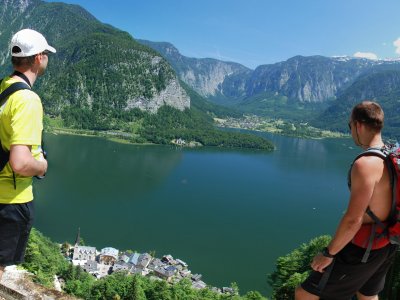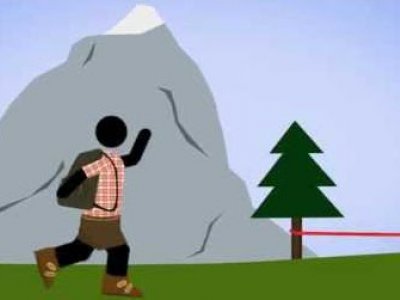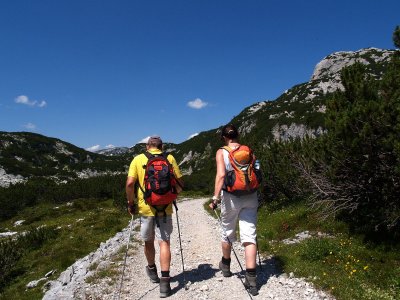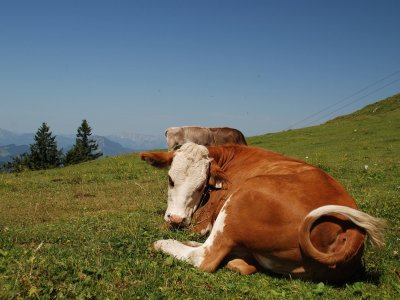Long-distance and long-distance hiking trails in the Salzkammergut
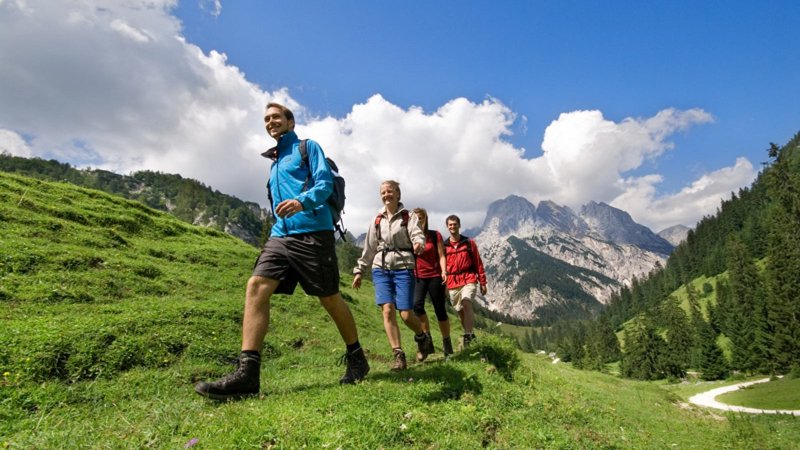
The route is the goal
Hiking is always possible. Hiking can be done anywhere. Sometimes it's more of a walk in the park – sometimes it's bordering on an expedition. While "normal" hikes usually last a few hours, a whole day or even a weekend, long-distance hiking trails with several hundred or even thousands of kilometers are more likely to last a few weeks or months.
Experience the Salzkammergut on new paths
Discover the Salzkammergut and the neighbouring regions on the most beautiful long-distance hiking trails! Start unforgettable hikes and run through eventful mythical landscapes. Let yourself be surprised by people, cultures and stories along the way. Think and hike limitlessly. Find your places of longing. Out there. In the Salzkammergut.
Packing list for long-distance hikes
Long-distance hiking, trekking, pilgrimage - the longer the hike, the more important the right equipment is. It is not so easy to find the right balance: as little weight as possible, as much equipment as necessary. Because every long-distance hiking trail and every person is different, we only present you a suggestion for a packing list to help you with individual planning.
Basic equipment for long-distance hiking trails
Every long-distance hiking trail has different requirements for equipment. The geographical location and difficulty of the route, the season, the weather, the chosen accommodations must be taken into account in the planning. However, some pieces of equipment should not be missing on any longer tour.
You can find a packing list for shorter day hikes here: Packing list for hiking
Backpack
The heart of any trekking equipment is the backpack. Depending on the length of the tour, it should hold between 40 and 70 liters for long-distance hiking and be perfectly adapted to your body shape. A low weight, a good carrying system and many easily accessible compartments make carrying a bit easier. Before you start, you should try a test hike with the packed
Footwear
Almost more important than the backpack are the hiking boots. They must be stable and comfortable and must be well broken in before the tour. Light trekking shoes or sturdy mountain boots? It depends on the type of tour and your personal preferences. In any case, get detailed advice from the specialist shop, because nothing you regret more when long-distance hiking than the wrong footwear!
In addition to your hiking boots, you should always have a second pair of light (hut) shoes or sandals with you for the evening when hiking long-distance.
Clothing: Underwear and other
Functional underwear warms in cool temperatures and is breathable and quick-drying in heat. Elastic material (merino wool, polyester) with flat seams that fits the body like a second skin is ideal.
- Underpants, sports bra
- Two or three pairs of trekking socks
- Nightwear
- Multifunctional scarf, hat or cap
- Gloves
- Sunglasses
- Telescopic hiking poles
- Photo: Catstyecam, Adobe Stock
Adjustable telescopic poles give you a secure grip on difficult terrain, support the muscles when walking uphill and relieve your knees when going downhill.
The correct pole length is measured by body height (rule of thumb: height x 0.68). However, this only applies to flat terrain – they should be a little shorter when going uphill, and a little longer when going downhill.
First aid kit
A complete first aid kit should not be missing on any long-distance hike. All items that come into contact with open wounds must be sterile packed and replaced after a single use. Ready-packed sets are available from many manufacturers, but you should check the backpack pharmacy for completeness before you start hiking:
Blister plasters
non-stick compresses
a large plaster
several small plasters (best for self-cutting)
two wound dressings
Alcohol swabs for disinfection
Triangular scarf
Adhesive plaster roll
Bandage scissors with blunt tip
Tweezers
Disposable gloves
Bivouac bag or rescue blanket
Signal whistle
Painkillers
Toiletries
Don't forget sunscreen!
Don't forget sunscreen!
The famous sawed-off toothbrush to save a few grams of weight is more of a running gag among long-distance hikers. Even if you don't want to go that far, you can reduce a lot of weight with good planning.
Toothbrush and toothpaste
Travel-sized soap and shampoo
Sunscreen with a high sun protection factor
Disinfectant
Skin cream and lip balm
Microfibre travel towel (quick-drying)
Razor
Feminine hygiene products
Toilet paper and tissues
Mückenspray
Comb and hair ties
Food and cooking equipment
If there are many places to stop for refreshments along the way, only water bottles and snacks should be in your backpack. When trekking through the wilderness, on the other hand, cooking equipment and food must be carried for the entire hike - a large proportion of the total weight of the backpack.
- Drinking bottles (2 x 1 litre) made of BPA-free plastic or hydration bladder with drinking tube
- For cool temperatures: lightweight thermos bottle for hot drinks
- Water
- Provisions and snacks (e.g. trekking dry food, muesli, energy bars, coffee powder)
- Pocket knife
- Gas stove and cartridge
- Pot
- Spoon
Electronics and other equipment
Multi-tool with knife and integrated tool
Mobile phone, charging cable and power bank, solar charger if necessary
Map material: If the mobile phone battery runs out on the road, the classic paper map is indispensable.
- Camera with accessories
- Headlamp
- Seat Pad
- Small garbage bags
- some duct tape for repairs
- Travel documents (IDs, booking information, health insurance card)
- Cash
Additional equipment when camping
Foto: Red Riding Hood, Adobe Stock
You can't get any closer to nature, but you can carry much more weight with you on this type of long-distance hiking. If you want to camp near the trail, it is essential to inform yourself in advance about the local rules for nature conservation, especially for (wild) camping and making fires. Designated tent sites should be reserved in advance if necessary.
In any case, the equipment includes:
- Tent and pegs
- Isomatte
- Sleeping bag
- Cooking equipment and provisions for all hiking days until the next shopping opportunity, see above
- Biodegradable Hand Wash and Clothesline
- Telephone number and booking confirmation for campsites
Additional equipment for hut tours
For the very first major hike, trekking with a tent is only conditionally recommended. Newcomers prefer to approach the adventure of long-distance hiking on paths with good infrastructure. Those who are out and about in the mountains can often spend the night in huts and enjoy the sunrise high up in the mountains the next morning.
However, multi-day hut tours should be planned precisely and the overnight stays booked in advance. Especially in the Alps, many popular huts are booked up very quickly. What you should have with you:
- Hut shoes
- Hut sleeping bag
- Earplug
- If applicable, Alpine Club ID and/or booking confirmation
- Telephone number of the hut
- Cash in local currency
Additional equipment in winter
Long-distance hikes are also possible in the winter months! However, there are many things to consider during the planning stage. Which accommodations are open? Are all paths on the route safe to walk on in winter? How long and difficult can the stages be so that you can still get to your accommodation in time when there is less daylight? Are the garments (especially the shoes!) well insulated, warm and waterproof?
When long-distance hiking in winter, you should pay even more attention to the weather forecast than in summer, because cold temperatures, snowfall and poor visibility can make hiking quite dangerous. But if you are properly prepared and equipped, you can enjoy the solitude in the snow and the adventure of long-distance hiking in winter! The following should be included:
- Warm gloves, balaclava or hat and scarf
- Plate attachments for telescopic poles
- Thermos
- Long underwear and extra warm layer clothing
- Snowshoes
- Grödeln
- Warm sleeping bag for overnight stays in huts and for camping
- Recommended reading
Unplug and just switch it off
Everyday problems are put on hold for a while, while the biggest concern is the crease in the sock. But which of the countless long-distance hiking trails in the Salzkammergut should you choose? What paths are there at all? Does one of them also fit into my vacation? We have compiled an overview of the most beautiful long-distance and long-distance hiking trails that run through the Salzkammergut for you below. Everything is there. From a 16-day tour or a 4-day hike. Everyone gets their money's worth with these offers. Warranted!
The most beautiful paths at a glance
Salzkammergut long distance hiking trail
In 18 days through one of Europe’s most enchanting landscapes. Hike with us along the Salzkammergut distant hiking trail through Austria’s 10th state!
Hiking on the “Salt Alps climb” trail
Hallsattt / Chiemsee | SalzAlpenSteig (Salt Alps climb): Premium long-distance trail from the oldest salt mine until the "Bavarian Sea" – Connected by 233 kilometres!
Dachstein hiking tour
The Dachstein and its surrounding regions are a magnet for all hiking fans, home to one of the most beautiful hiking tours in all of the Alps, leading out through Styria, Upper Austria and Salzburg. Hiking in 8 stages. With luggage shuttle. Every day new fascinating landscape and rustic people.
Theme trail "Salzkammergut Brine Trail" ("Salzkammergut Soleweg")
A unique path. With many informative boards on the subject of "salt mining". Join us on an impressive tour along the oldest pipeline in the world. A natural pleasure for "long-term walkers" and short-term hikers".
Safety tips for long-distance hikes
Theme trail "Salzkammergut Brine Trail" ("Salzkammergut Soleweg")
A unique path. With many informative boards on the subject of "salt mining". Join us on an impressive tour along the oldest pipeline in the world. A natural pleasure for "long-term walkers" and short-term hikers".
Safety Tips for Hiking
How do I prepare myself for a hiking tour? What do I take along in my backpack? What do I do and whom do I call during an emergency? Still have lots of questions? You’ll find the right answers here . . .
Your personal rucksack checklist
As is well known, preparation is everything. Here we give answers to the question "What belongs in my hiking backpack?" The most important things for a great hike.
10 rules of conduct for Austrian Alpine pastures and grazing areas
Also in summer, as hikers or walkers on the pastures, there are a number of things to be aware. When dealing with grazing livestock, there are some things to consider. Therefore here are the most important rules of conduct summarised.
Available accommodation for your hiking holiday in the Salzkammergut
Hotels and accommodation providers in Hallstatt, Bad Goisern, Gosau and Obertraun offer the ideal room or apartment for your holidays, no matter what your tastes. Aside from establishments rated according to the international "star" scale, you will also find around Lake Hallstatt in Austria businesses that have been awarded two to four "edelweiss". The more flowers, the greater comforts you can expect. Whether you eventually find your cozy nest in an elegant 5-star luxury hotel, at comfortable guesthouse, a family-friendly apartment, or on a traditional farm, the choice is always entirely up to you.

